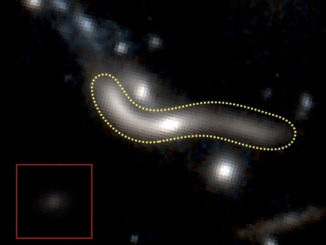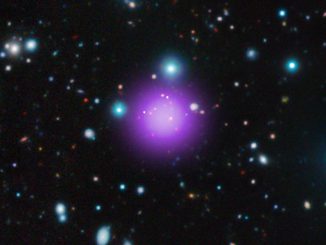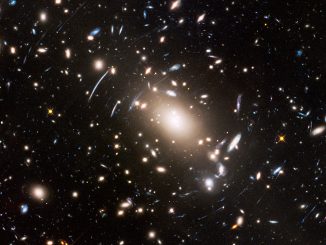
galaxy cluster


Major supercluster of galaxies found hidden by the Milky Way
An international team of astronomers has discovered a previously unknown major concentration of galaxies in the constellation Vela, which they have dubbed the Vela supercluster. The gravitational attraction from this large mass concentration in our cosmic neighbourhood may have an important effect on the motion of our Local Group of galaxies.

Record-breaking galaxy cluster discovered
A new record for the most distant galaxy cluster has been set using NASA’s Chandra X-ray Observatory and other telescopes. CL J1001+0220 is located about 11.1 billion light-years from Earth. The discovery of this object pushes back the formation time of galaxy clusters — the largest structures in the universe held together by gravity — by about 700 million years.

Hubble looks to the Final Frontier on 50th anniversary of “Star Trek”
The TV series “Star Trek” captured the public’s imagination with the signature phrase, “To boldly go where no one has gone before.” The NASA/ESA Hubble Space Telescope doesn’t “boldly go” deep into space, but it is “boldly peering” deeper into the universe than ever before to explore the warping of space and time and uncover some of the farthest objects ever seen.

Most distant massive galaxy cluster identified
The early universe was a chaotic mess of gas and matter that only began to coalesce into distinct galaxies hundreds of millions of years after the Big Bang. It would take several billion more years for such galaxies to assemble into massive galaxy clusters — or so scientists had thought. Now astronomers have detected a massive, sprawling, churning galaxy cluster that formed only 3.8 billion years after the Big Bang, some 10 billion light years from Earth.

Chandra finds a remarkable galactic ribbon unfurled
An extraordinary ribbon of hot gas trailing behind a galaxy like a tail has been discovered using data from NASA’s Chandra X-ray Observatory. This ribbon, or X-ray tail, is likely due to gas stripped from the galaxy as it moves through a vast cloud of hot intergalactic gas. With a length of at least 250,000 light-years, it is likely the largest such tail ever detected.

